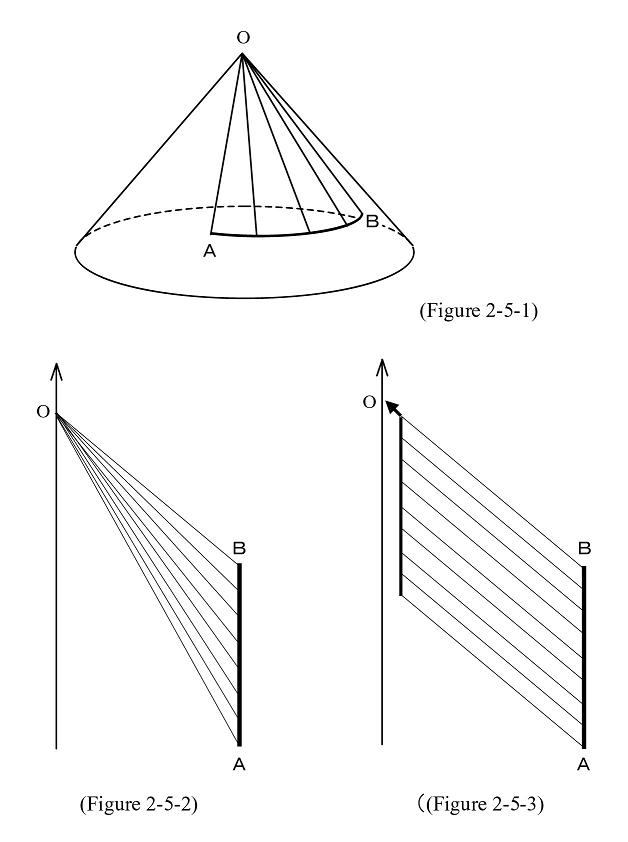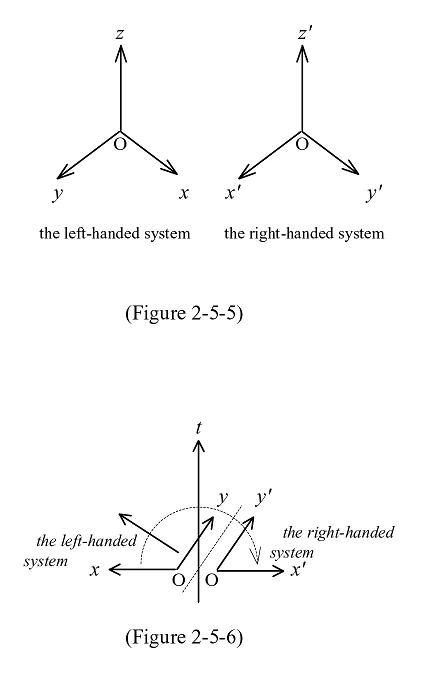A PHILOSOPHY OF THE FOUR-DIMENSIONAL SPACE-TIME
The Worldview of Relative Simultaneity (MURAYAMA Akira)
CHAPTER II The Problems of Continuity and Contradiction
5. The Difference between Space and Time
However, there are clear qualitative differences between space and time, at least in our consciousness. Our consciousness perceives time as something that continues to run. The space-time cross section of "now" can only be sequentially recognized as an object of continuous experience, whereas space enables us to freely travel through it and to see its entirety at a time. The question is what you think of these clear differences.
I will examine the "flow of time" in the next chapter. In this section, I demonstrate that the differences between space and time can be derived to a certain extent from the structure of four-dimensional space-time, which was presented by the theory of relativity, from the perspective of the following two questions.
[Question 1]
Why is time just recognized in a localized form called "now," while space is perceived as something that expands at a certain temporal point (this point has a certain extent of interval)? That is, why isn't time recognized as a certain expanse from the past to the future?
[Question 2]
Why can't we get back to the same temporal point whereas we can get back to the same spatial position?
These questions characterize the differences between space and time. Now, I consider the first question.
This structure of four-dimensional space-time is Riemann's space-time linearly based on Minkowski's space-time. In this context, it is appropriate to simply think about Minkowski's space-time without considering distorted gravitational fields. This four-dimensional space-time consists of three-dimensional space and one-dimensional time and I drew a simplified figure by reducing space dimension by one (See Figure 2-5-1).

In Figure 2-5-1, the origin O signifies the present recognizer. Curve A to B is an aggregation of space-time points (events) that are expanding in space. Each event has the means of simultaneous information transmission (for example, light) to the origin O. That is, due to the real existence of a structure that we can recognize spatial distance (expansion) simultaneously, we can truly perceive that space expands (has extension).
In the meantime, with regard to time, world-line A to B in Figure 2-5-2 is an aggregation of space-time points (events) that are expanding in space-time. Origin O refers to the present recognizer. The question is if there is any means of simultaneous information transmission here. The recognizer can simultaneously observe events expanding on world-line A to B in terms of time only when each event offers a means of information transmission with gradually and continuously different velocities such as light and the recognizer conducts the exceedingly complicated operation of choosing a slower means of information transmission for the farther past and choosing a faster means of information transmission for the nearer past. In fact, such a means of information transmission with continuously different velocities does not exist, and distinguishing between farther past information and nearer past information is impossible. As Figure 2-5-3 illustrates, this kind of thing would be possible if the recognizer has the postponed perception mechanism, in which received information is stored for a while to be collectively recognized later. In this scenario, the recognizer may be able to perceive time expansion at one time. In the world of computer graphics, some people invented such a mechanism and enjoy odd movies, but in the real world, such a mechanism is not possible. If such a mechanism were possible, it would not work advantageously in the survival race and would soon disappear.
In our consciousness, spatial expansion can be recognized at a certain spot, but time expansion cannot be perceived. This means that space-time structure and recognition mechanism are established only in such a way.
In addition, there is only one direction of information transference. The belief is that information transference from the future to the past is impossible (in the universe, to our knowledge, at least at a macroscopic level). If doing so were possible, serious problems in causal laws would occur. This may be related to some form of space-time structure. (I will examine time direction in Chapter 3.)

Next, I move on to the second question. The two curves in Figure 2-5-4 mean world-lines, or a series of space-time points. Curve A turns to the left, changes its course partway and returns to the starting point, which depends on a coordinate system. This type of world-line commonly exists in actual four-dimensional space-time. Curve B goes in the future direction, but changes its course partway and heads for the past. This type of world-line cannot exist in four-dimensional space-time. To actually make it happen, curve B must go beyond the speed of light, switch from the infinite velocity to the minus infinite velocity and travel from the ultra-speed of light to the under-speed of light. The theory of relativity shows that such process is impossible. We can travel back and forth in space, but we cannot do the same in time. The principal reason for not being able to travel back and forth in time, although it is possible in space, is the barrier of the speed of light.
If a thing shaped like world-line B can exist, a general outside observer would judge that two separate objects are approaching each other and vanish at the very moment they crash at the infinite velocity beyond the speed of light. Of course, such a physical phenomenon has never been observed.
To supplement these arguments, although the world is four-dimensional, it is not mathematically abstracted four-dimensional Euclidean space. I can mention several points indicating that four-dimensional geometrical factors inherent in four-dimensional Euclidean space cannot exist in Minkowski's four-dimensional space-time where we live.

For example, the belief is that the left-handed system (x, y, z) and the right-handed system (x', y', z') illustrated in Figure 2-5-5 cannot be exactly overlapped in three-dimensional Euclidean space if any type of revolution and translation are conducted, but that is considered possible in four-dimensional Euclidean space. Figure 2-5-6 is the simplified two-dimensional explanation of this logic. For the left-handed system (x, y) and the right-handed system (x', y'), x and x' and y and y' cannot be overlapped if any type of revolution and translation are conducted in two-dimensional surface. However the overlapping is possible if you conduct a rotation of "turning them over" in three-dimensional space. By the same token, the belief is that mathematically even if the overlapping is impossible in three-dimensional space, it will definitely be possible by reversing in four-dimensional space. In actuality, the two systems cannot be switched. The reason for this may also be the barrier of the speed of light. To conduct a rotation to reverse in Figure 2-5-6, you have to slant the space axis just like inverting it, but the slanting of the space axis can, at most, be close to the slant representing the speed of light. Compared with simple Euclidean four-dimensional space, in the actual Minkowski four-dimensional space-time presented by the theory of relativity, rotation is restricted.
Space and time are clearly different in nature in our consciousness, but I think it too optimistic to perceive the objective forms of space and time in accordance with our consciousness. Just as color cannot simply be regarded as the attribute of an object itself, our directly perceived facts should not be blindly taken for granted as the attributes of reality. That is the basic attitude developed by the scientifically critical modern spirit. It is quite possible to explain that though space and time are just different cross sections of four-dimensional space-time with the same nature, they are perceived as different in nature due to their geometrical structures.
However, I do not think that the discussions in this section completely cover everything about our recognition of space and time. The question is why our consciousness scans space-time in the direction from the past to the future. I am not sure why our consciousness scans in the direction, but one thing is certain: time flow should be considered a representation of our consciousness in four-dimensional space-time. Some may believe that our consciousness in time flow constructs the concept of four-dimensional space-time, but I do not think so.